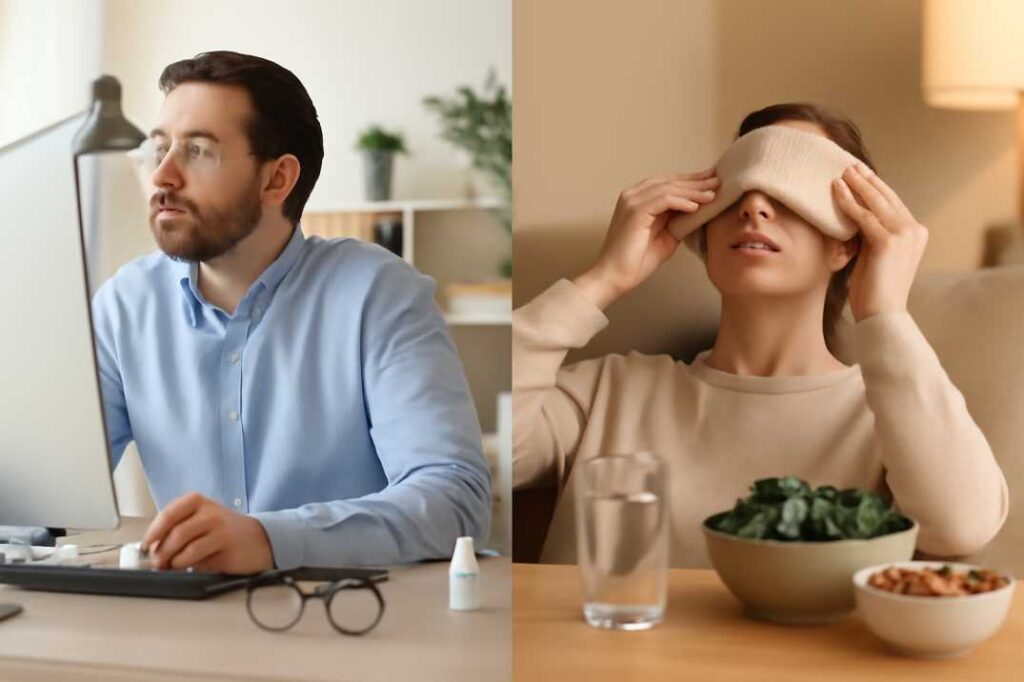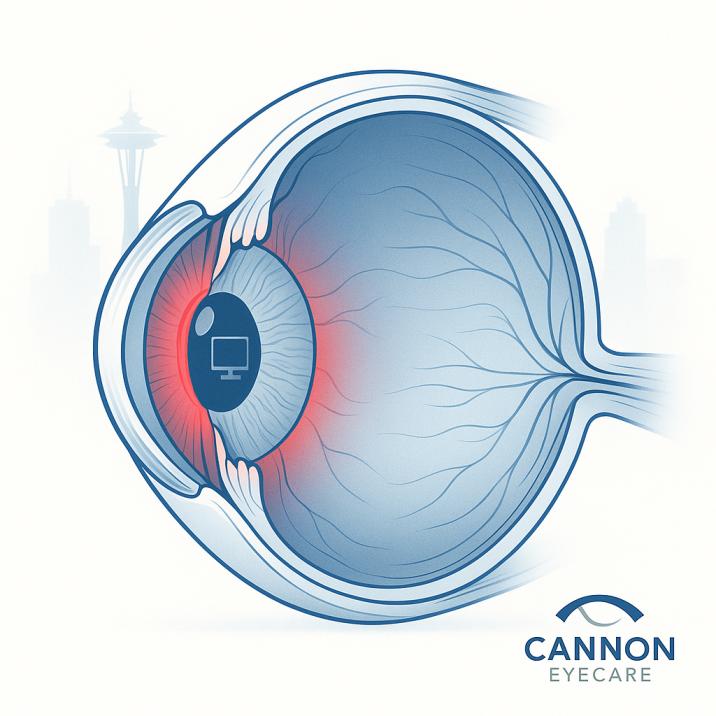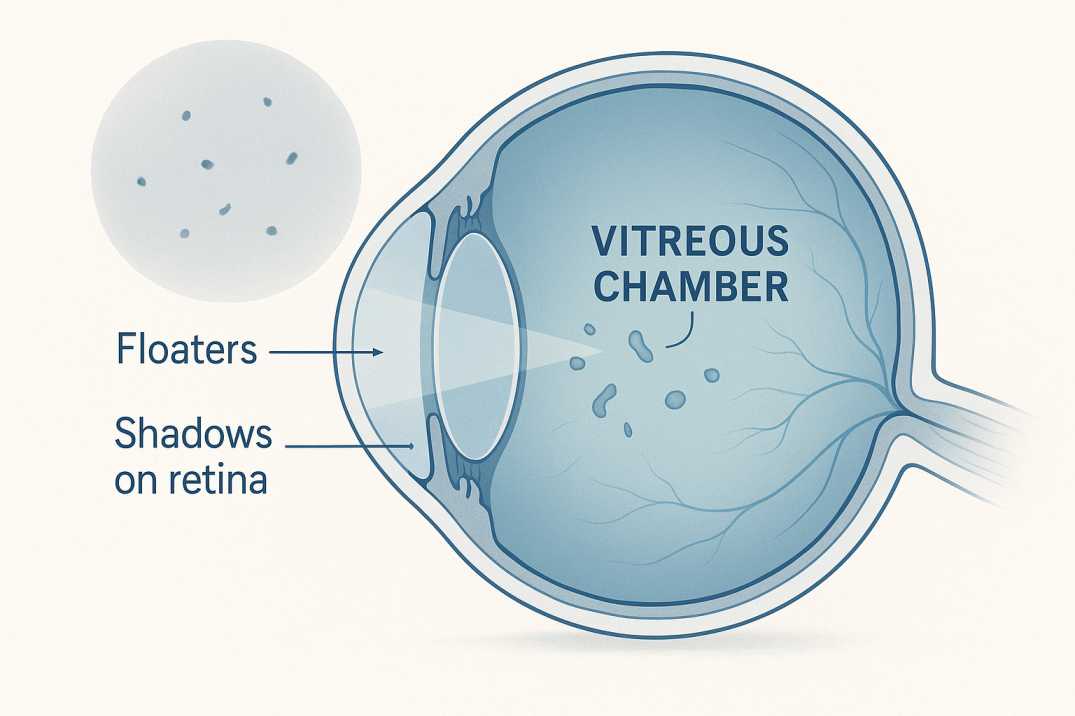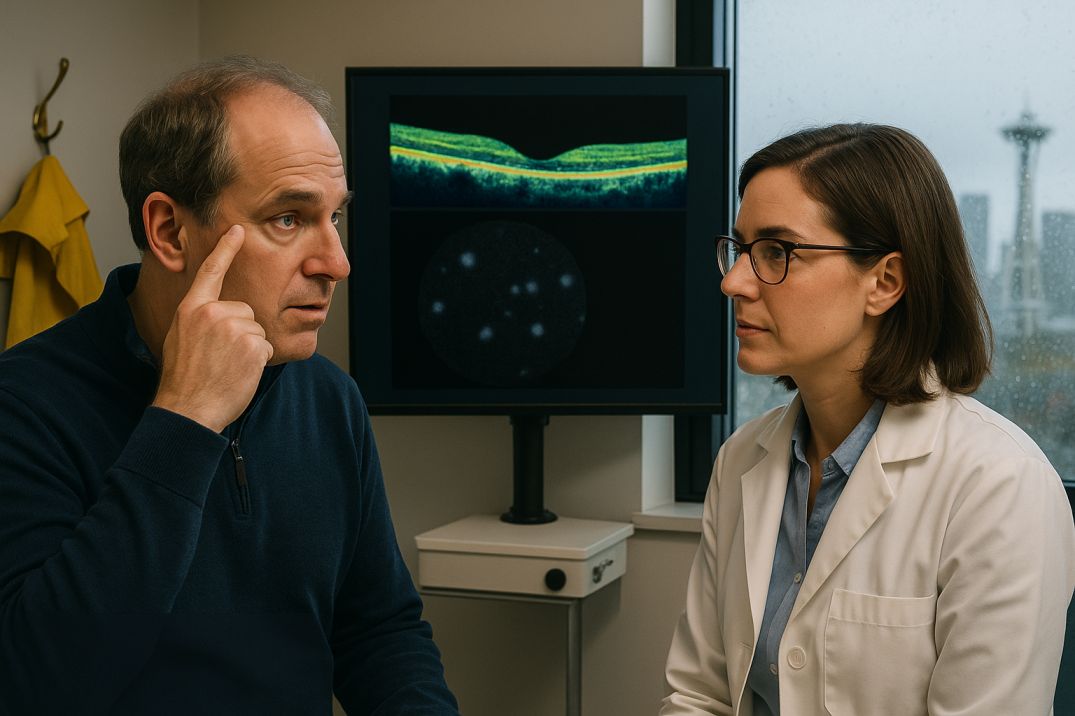Eye Twitching
Bottom Line Up Front: Eye twitching (eyelid myokymia) affects nearly everyone at some point and is usually harmless, commonly caused by stress, fatigue, or caffeine intake. Most episodes of eye twitching resolve within days with simple lifestyle adjustments, such as improving sleep hygiene, managing stress, and reducing caffeine consumption. However, persistent eyelid twitching lasting over a week, affecting your vision, or accompanied by other facial spasms warrants professional eye care evaluation to rule out underlying neurological conditions.
Have you ever been in the middle of an important meeting when your eyelid suddenly starts its own little dance party? That annoying, involuntary fluttering sensation—medically known as eye twitching, eyelid myokymia, or blepharospasm—is one of the most common yet misunderstood symptoms affecting the eyes. While that persistent twitch might make you worry about your health, understanding what causes eye twitching and how to stop eye twitching can bring both relief and peace of mind.
At Cannon EyeCare, we frequently see patients concerned about eye twitching, especially in our fast-paced Seattle community, where stress and screen time are daily realities. Through our comprehensive approach to eye health, we’ve helped countless patients understand this common condition and find effective solutions. Let’s explore everything you need to know about eye twitching—from why it happens to when you should be concerned.
Understanding Eye Twitching: More Than Just an Annoyance
Eye twitching refers to involuntary, repetitive spasms of the muscles around your eye, particularly the orbicularis oculi muscle that controls eyelid movement. These spasms create that characteristic fluttering or pulsing sensation that can be more noticeable to you than to others observing.
Types of Eye Twitching
Eyelid Myokymia (Simple Eye Twitching) This is by far the most common type, affecting the upper or lower eyelid with gentle, rippling contractions. These twitches typically:
- Last seconds to minutes at a time
- Occur sporadically over days or weeks
- They are barely visible to others
- Cause no pain or vision changes
- Resolve on their own
Benign Essential Blepharospasm: A more severe form involving both eyes, characterized by:
- Sustained, forceful eyelid closure
- Difficulty keeping eyes open
- Potential functional impairment
- Progressive worsening over time
- Need for medical intervention
Hemifacial Spasms: A rare condition affecting one side of the face, starting with eyelid twitching but potentially spreading to other facial muscles.
The Science Behind Eye Twitching: What’s Really Happening
Your eyelids contain intricate muscle networks that contract thousands of times daily for blinking and eye protection. When these muscles become overstimulated or fatigued, they can begin firing irregular electrical signals, creating the twitching sensation.
Recent research has identified several physiological mechanisms:
Neurological Factors
The facial nerve (seventh cranial nerve) controls eyelid movement. When this nerve becomes irritated or overstimulated, it can trigger involuntary muscle contractions. Stress hormones like cortisol can heighten nerve sensitivity, making twitching more likely during challenging periods.
Muscle Fatigue
Your eyelid muscles work continuously throughout waking hours. Digital eye strain from prolonged screen use forces these muscles to work overtime, leading to microscopic fatigue that manifests as twitching.
Electrolyte Imbalances
Essential minerals like magnesium, potassium, and calcium play crucial roles in muscle function. Even minor deficiencies can affect muscle contractions and nerve signaling, potentially triggering eye twitches.
What Causes Eye Twitching: Identifying Your Personal Triggers
Understanding what triggers your eye twitching is the first step toward prevention and treatment. Based on current research and clinical experience, here are the primary culprits:
Stress and Anxiety
Why it happens: Chronic stress elevates cortisol levels, which can overstimulate nerve pathways and increase muscle tension throughout your body, including around your eyes.
The Seattle connection: Our fast-paced professional environment often creates perfect conditions for stress-induced eye twitching. Many of our patients notice twitching increases during particularly demanding work periods.
Sleep Deprivation and Fatigue
The impact: Getting less than 7-8 hours of quality sleep weakens your nervous system’s ability to regulate muscle function properly.
What research shows: Studies indicate that sleep-deprived individuals are significantly more likely to experience muscle spasms and twitches throughout their bodies.
Caffeine Overconsumption
The mechanism: Caffeine stimulates your central nervous system, and excessive intake can lead to overstimulation of nerve pathways controlling muscle movement.
Practical threshold: The FDA maintains that 400 milligrams is the upper daily limit for caffeine consumption, which equals approximately four 8-ounce cups of brewed coffee, though individual sensitivity varies greatly.
Digital Eye Strain
Modern reality: Extended screen time forces your eyes to work harder, leading to muscle fatigue and increased blink rates that can trigger twitching.
The 20-20-20 rule solution: Every 20 minutes, look at something 20 feet away for at least 20 seconds to give your eye muscles a break.
Dry Eyes and Eye Irritation
The connection: When your eyes lack adequate lubrication, they become irritated, leading to increased blinking and potential muscle spasms.
Environmental factors: Wind, air conditioning, and allergies can exacerbate dry eye symptoms and increase twitching likelihood.
Nutritional Deficiencies
Key minerals: Magnesium, potassium, and calcium deficiencies can all contribute to muscle spasms and twitching.
Dietary considerations: Poor nutrition or restrictive diets may contribute to these deficiencies, particularly in busy professionals who rely heavily on processed foods.
Alcohol and Nicotine
How they contribute: Both substances affect your nervous system and can increase the likelihood of muscle spasms. Alcohol can also contribute to dehydration, which affects muscle function.
Bright Lights and Environmental Irritants
Photosensitivity: Sudden exposure to bright lights can trigger protective muscle responses that sometimes result in twitching.
Allergies: Seasonal allergies, causing eye irritation and excessive rubbing, can lead to muscle fatigue and subsequent twitching.
When Eye Twitching Becomes Concerning: Red Flags to Watch For
While most eye twitching is benign and temporary, certain symptoms warrant immediate professional attention. At Cannon EyeCare, we always recommend erring on the side of caution when it comes to your vision health.
Seek Immediate Medical Attention If You Experience:
Persistent Twitching (Over One Week)
- Continuous twitching for more than seven consecutive days
- Twitching that interferes with daily activities
- No improvement with lifestyle modifications
Vision Changes or Eye Closure
- Complete eyelid closure with each twitch
- Difficulty keeping eyes open
- Any changes in vision clarity or focus
- Double vision or blurred vision
Spreading to Other Facial Areas
- Twitching affecting other parts of your face
- Muscle spasms in your cheek, mouth, or neck
- One-sided facial weakness or drooping
Accompanying Symptoms
- Eye redness, swelling, or discharge
- Severe eye pain or sensitivity to light
- Drooping eyelids (ptosis)
- Facial numbness or weakness
Neurological Warning Signs
- Slurred speech or difficulty speaking
- Weakness in arms or legs
- Confusion or difficulty concentrating
- Severe headaches
Potential Underlying Conditions
While rare, persistent eye twitching can occasionally indicate more serious conditions:
Benign Essential Blepharospasis m A neurological disorder causing involuntary eyelid closure, more common in middle-aged and older women.
Hemifacial Spasm is typically caused by blood vessel compression of the facial nerve, resulting in one-sided facial muscle spasms.
Multiple Sclerosis. In very rare cases, eye twitching can be an early symptom of MS, usually accompanied by other neurological symptoms.
Bell’s Palsy: Facial nerve inflammation that can cause various facial muscle abnormalities, including twitching.
How to Stop Eye Twitching: Effective Treatment Strategies
The good news is that most eye twitching responds well to simple interventions. Here’s a comprehensive approach to stopping and preventing eye twitches:
Eye Twitching Home Remedies for Immediate Relief
Apply Warm Compresses
- Soak a clean washcloth in warm (not hot) water
- Apply to closed eyelids for 10-15 minutes
- Repeat 2-3 times daily to relax muscle tension
Gentle Eyelid Massage
- Use clean fingers to gently massage the affected eyelid in small circles
- Apply light pressure and move slowly to avoid irritation
- Focus on the areas where twitching is most noticeable
Conscious Blinking Exercises
- Deliberately blink slowly and completely
- Hold each blink for 2-3 seconds
- Repeat 10-15 times to reset muscle function
Eye Drops for Lubrication
- Use preservative-free artificial tears to combat dryness
- Apply as needed throughout the day, especially during screen use
- Consider nighttime lubricating gels for severe dry eye
Lifestyle Modifications for Long-term Prevention
Optimize Your Sleep Schedule
- Aim for 7-9 hours of quality sleep nightly (as recommended by the American Academy of Sleep Medicine and CDC)
- Maintain consistent bedtime and wake-up times
- Create a cool, dark, quiet sleep environment
- Avoid screens for at least one hour before bed
Stress Management Strategies
- Practice deep breathing exercises or meditation
- Incorporate regular physical exercise into your routine
- Consider yoga or tai chi for mind-body relaxation
- Schedule regular downtime and hobby activities
Dietary Adjustments
- Gradually reduce caffeine intake if you consume more than 400mg daily
- Increase water intake to maintain proper hydration (about 11-13 cups daily for adults, according to the National Academy of Medicine)
- Include magnesium-rich foods like leafy greens, nuts, and seeds
- Consider a balanced multivitamin if dietary intake is inadequate
Digital Eye Strain Prevention
- Follow the 20-20-20 rule religiously
- Adjust screen brightness to match surrounding lighting
- Position screens 20-26 inches from your eyes
- Use blue light filtering glasses if helpful
Environmental Modifications
- Use a humidifier in dry environments
- Wear wraparound sunglasses outdoors to protect from wind and bright light
- Address allergies with appropriate medications or environmental controls
- Keep your eyes clean and avoid excessive rubbing
Professional Treatment Options
When home remedies aren’t sufficient, several medical treatments can provide relief:
Botulinum Toxin (Botox) Injections
- Highly effective for persistent twitching with an 80-90% success rate
- Temporarily paralyzes overactive muscles
- Effects typically last 3-4 months
- Cost ranges from $300-$800 per treatment session (2025 pricing)
- Usually requires 10-30 units for eye twitching treatment
Prescription Medications
- Muscle relaxants for severe cases
- Anti-seizure medications for specific types of spasms
- Dopamine-affecting medications in certain situations
Surgical Intervention (Rare)
- Orbicularis myectomy for severe, treatment-resistant cases
- Involves the removal of portions of the eyelid muscle
- Reserved for cases where other treatments have failed
- Success rate of 80-90% when appropriately indicated
Eye Twitching Prevention: Keeping Eyelid Spasms at Bay
Prevention is always preferable to treatment. Here’s how to minimize your risk of developing eye twitching:
Daily Habits for Eye Health
Morning Routine
- Start with adequate hydration (16-20oz of water upon waking)
- Include eye-healthy foods in breakfast (berries, eggs, leafy greens)
- Apply sunscreen around the eyes before outdoor activities
Workday Strategies
- Position your computer screen slightly below eye level
- Use proper lighting to reduce screen glare
- Take regular breaks from concentrated visual tasks
- Keep artificial tears readily available
Evening Wind-down
- Limit caffeine after 2 PM (following FDA guidelines)
- Create a relaxing pre-sleep routine
- Use warm compresses if the eyes feel strained
- Practice stress-reduction techniques
Long-term Lifestyle Approaches
Nutrition Focus
- Emphasize whole foods rich in eye-supporting nutrients
- Include omega-3 fatty acids from fish or supplements
- Maintain stable blood sugar levels with balanced meals
- Stay consistently hydrated throughout the day
Exercise and Movement
- Regular cardiovascular exercise supports overall nerve health
- Yoga and stretching can reduce muscle tension
- Face and neck exercises may help prevent facial muscle issues
- Develop healthy coping mechanisms for work stress
- Consider counseling or therapy during particularly challenging periods
- Build strong social support networks
- Practice mindfulness or meditation regularly
Recent Research and Scientific Developments
Recent studies have provided new insights into eye twitching causes and treatments:
COVID-19 and Eye Twitching
A 2021 study published in medical journals found that some patients developed eyelid myokymia during or immediately after COVID-19 recovery. The research showed that recovery time was influenced by age and duration of hospitalization, with most patients experiencing complete resolution within three months. This adds to our understanding of potential post-viral complications affecting eye health.
Gender and Age Patterns
Current research indicates that eyelid twitching is more common in middle-aged and older women, particularly those between 50-70 years old. Interestingly, cold weather has also been identified as a risk factor for chronic eyelid myokymia, which may be particularly relevant for our Seattle-area patients during the winter months.
Digital Eye Strain Impact
With increased screen time becoming permanent since 2020, researchers have documented a significant rise in digital eye strain-related symptoms, including an increased incidence of eye twitching among remote workers and students. The 2025 data shows this trend continues, making prevention strategies more crucial than ever.
The Cannon EyeCare Approach: Comprehensive, Personalized Care
At Cannon EyeCare, we understand that eye twitching, while often benign, can significantly impact your daily life and peace of mind. Our approach combines thorough evaluation with personalized treatment strategies that address your unique circumstances.
What to Expect During Your Visit
Comprehensive Eye Examination Our detailed examination goes beyond basic vision testing to assess:
- Overall eye health and function
- Tear film quality and dry eye assessment
- Muscle function and coordination
- Signs of underlying conditions
Detailed History Taking We’ll discuss:
- Your specific twitching patterns and triggers
- Lifestyle factors that might contribute
- Previous treatments you’ve tried
- Any accompanying symptoms or concerns
Personalized Treatment Planning Based on our findings, we’ll develop a customized approach that might include:
- Specific lifestyle modifications for your situation
- Appropriate treatments for any underlying conditions
- Follow-up scheduling to monitor progress
- Referrals to specialists if needed
When to Schedule Your Appointment
Don’t let persistent eye twitching disrupt your life. Contact Cannon EyeCare if you experience:
- Twitching lasting more than a week
- Any vision changes or eye discomfort
- Concerns about underlying causes
- Need for professional guidance on treatment options
Our convenient Seattle locations in University Village and Pike Place Market make it easy to get the expert care you need without disrupting your busy schedule.
Living with Eye Twitching: Patient Success Stories and Tips
Many of our patients have successfully overcome persistent eye twitching by implementing comprehensive lifestyle changes and receiving appropriate professional care. Here are some common success strategies:
Real-World Solutions That Work
The Busy Professional Approach: One of our tech industry patients resolved chronic eyelid twitching by:
- Setting phone reminders for regular screen breaks
- Switching to decaf coffee after 10 AM
- Using a standing desk to reduce overall tension
- Incorporating 10-minute meditation breaks into his workday
The Stress Management Successes: As a healthcare worker eliminated her eye twitching by:
- Practicing yoga three times weekly
- Improving sleep hygiene with a consistent bedtime routine
- Using blue light blocking glasses during evening screen time
- Taking magnesium supplements under medical supervision
Additional Resources and Citations
For readers seeking more detailed medical information about eye twitching, the following authoritative sources provided key research and guidelines used in this article:
1. Eyelid Myokymia – StatPearls Medical Reference
National Center for Biotechnology Information (NCBI)
https://www.ncbi.nlm.nih.gov/books/NBK560595/
This comprehensive medical reference provides detailed clinical information about eyelid myokymia, including diagnostic criteria, treatment approaches, and when specialist referral is indicated. Updated August 2023.
2. Sleep Duration Recommendations – Centers for Disease Control and Prevention
CDC Sleep Health Guidelines
https://www.cdc.gov/sleep/about/index.html
Official CDC guidance on healthy sleep duration for adults (7+ hours nightly) and the health impacts of insufficient sleep. This resource informed our sleep-related prevention strategies. Updated February 2025.
3. Caffeine Guidelines – U.S. Food and Drug Administration
FDA Consumer Information on Caffeine Safety
https://www.fda.gov/consumers/consumer-updates/spilling-beans-how-much-caffeine-too-much
Current FDA recommendations for safe daily caffeine consumption (400mg limit for healthy adults), which directly informed our guidance on caffeine reduction as a prevention strategy.
These resources represent peer-reviewed medical literature and official health agency guidelines that informed the evidence-based recommendations in this article.
Take Control of Your Eye Health Today
Eye twitching may be common, but it doesn’t have to be a permanent part of your life. By understanding the causes, implementing appropriate lifestyle changes, and seeking professional care when needed, you can regain control and peace of mind.
Remember, your vision is precious, and even seemingly minor symptoms deserve attention. At Cannon EyeCare, we’re committed to providing the comprehensive, personalized care you need to maintain optimal eye health throughout your life.
Ready to address your eye twitching concerns and get professional eye care? Contact Cannon EyeCare today to schedule your comprehensive eye examination. Our experienced Seattle eye doctors are here to provide the expert care and personalized guidance you need to see clearly and comfortably. Schedule your appointment online or call our University Village location.
This article is for informational purposes only and should not replace professional medical advice. If you’re experiencing persistent eye twitching or any concerning eye symptoms, please consult with a qualified eye care professional for proper evaluation and treatment.
FAQs
-
Eye twitching is typically caused by stress, lack of sleep, excessive caffeine intake, dehydration, or magnesium deficiency in otherwise healthy individuals.




